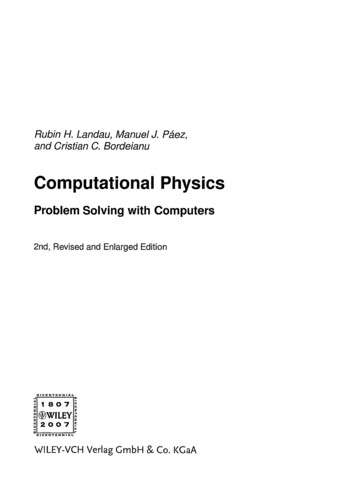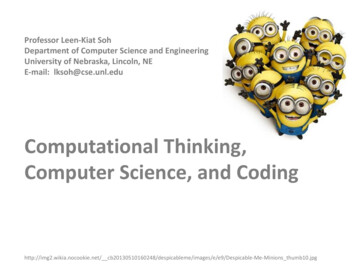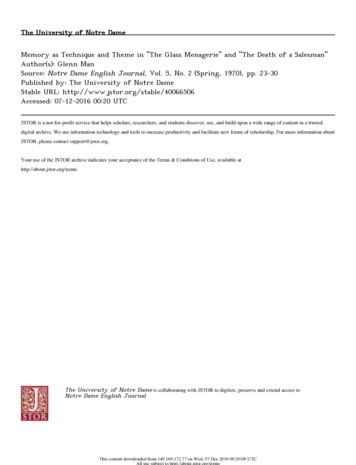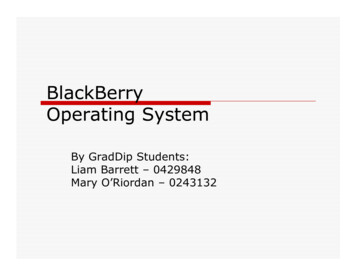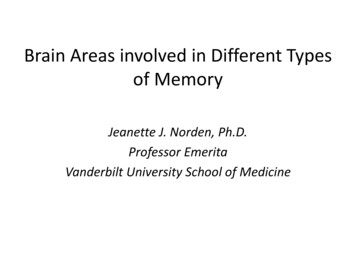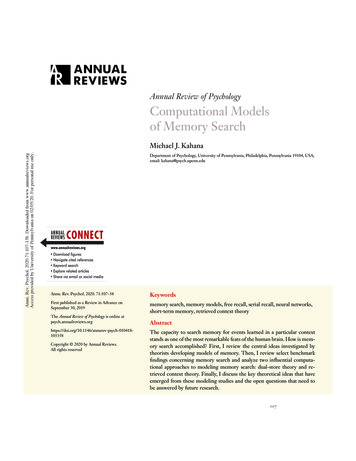
Transcription
PS71CH05 KahanaARjats.clsNovember 27, 201911:47Annual Review of PsychologyComputational Modelsof Memory SearchAnnu. Rev. Psychol. 2020.71:107-138. Downloaded from www.annualreviews.orgAccess provided by University of Pennsylvania on 02/05/20. For personal use only.Michael J. KahanaDepartment of Psychology, University of Pennsylvania, Philadelphia, Pennsylvania 19104, USA;email: kahana@psych.upenn.eduAnnu. Rev. Psychol. 2020. 71:107–38KeywordsFirst published as a Review in Advance onSeptember 30, 2019memory search, memory models, free recall, serial recall, neural networks,short-term memory, retrieved context theoryThe Annual Review of Psychology is online nnurev-psych-010418103358Copyright 2020 by Annual Reviews.All rights reservedAbstractThe capacity to search memory for events learned in a particular contextstands as one of the most remarkable feats of the human brain. How is memory search accomplished? First, I review the central ideas investigated bytheorists developing models of memory. Then, I review select benchmarkfindings concerning memory search and analyze two influential computational approaches to modeling memory search: dual-store theory and retrieved context theory. Finally, I discuss the key theoretical ideas that haveemerged from these modeling studies and the open questions that need tobe answered by future research.107
PS71CH05 KahanaARjats.clsNovember 27, 201911:47ContentsAnnu. Rev. Psychol. 2020.71:107-138. Downloaded from www.annualreviews.orgAccess provided by University of Pennsylvania on 02/05/20. For personal use only.1. INTRODUCTION . . . . . . . . . . . . . . . . . . . . . . . . . . . . . . . . . . . . . . . . . . . . . . . . . . . . . . . . . . .2. MODELS FOR MEMORY . . . . . . . . . . . . . . . . . . . . . . . . . . . . . . . . . . . . . . . . . . . . . . . . . . . .2.1. What Is a Memory Model? . . . . . . . . . . . . . . . . . . . . . . . . . . . . . . . . . . . . . . . . . . . . . . . .2.2. Representational Assumptions . . . . . . . . . . . . . . . . . . . . . . . . . . . . . . . . . . . . . . . . . . . . .2.3. Multitrace Theory . . . . . . . . . . . . . . . . . . . . . . . . . . . . . . . . . . . . . . . . . . . . . . . . . . . . . . . .2.4. Composite Memories . . . . . . . . . . . . . . . . . . . . . . . . . . . . . . . . . . . . . . . . . . . . . . . . . . . . .2.5. Summed Similarity . . . . . . . . . . . . . . . . . . . . . . . . . . . . . . . . . . . . . . . . . . . . . . . . . . . . . . . .2.6. Pattern Completion . . . . . . . . . . . . . . . . . . . . . . . . . . . . . . . . . . . . . . . . . . . . . . . . . . . . . . .2.7. Contextual Coding . . . . . . . . . . . . . . . . . . . . . . . . . . . . . . . . . . . . . . . . . . . . . . . . . . . . . . . .3. ASSOCIATIVE MODELS . . . . . . . . . . . . . . . . . . . . . . . . . . . . . . . . . . . . . . . . . . . . . . . . . . . . .3.1. Recognition and Recall . . . . . . . . . . . . . . . . . . . . . . . . . . . . . . . . . . . . . . . . . . . . . . . . . . . .3.2. Serial Learning . . . . . . . . . . . . . . . . . . . . . . . . . . . . . . . . . . . . . . . . . . . . . . . . . . . . . . . . . . .4. BENCHMARK RECALL PHENOMENA . . . . . . . . . . . . . . . . . . . . . . . . . . . . . . . . . . . . .4.1. Serial Position Effects . . . . . . . . . . . . . . . . . . . . . . . . . . . . . . . . . . . . . . . . . . . . . . . . . . . . .4.2. Contiguity and Similarity Effects . . . . . . . . . . . . . . . . . . . . . . . . . . . . . . . . . . . . . . . . . . .4.3. Recall Errors . . . . . . . . . . . . . . . . . . . . . . . . . . . . . . . . . . . . . . . . . . . . . . . . . . . . . . . . . . . . . .4.4. Interresponse Times . . . . . . . . . . . . . . . . . . . . . . . . . . . . . . . . . . . . . . . . . . . . . . . . . . . . . . .5. MODELS FOR MEMORY SEARCH . . . . . . . . . . . . . . . . . . . . . . . . . . . . . . . . . . . . . . . . . .5.1. Dual-Store Theory . . . . . . . . . . . . . . . . . . . . . . . . . . . . . . . . . . . . . . . . . . . . . . . . . . . . . . . .5.2. Retrieved Context Theory . . . . . . . . . . . . . . . . . . . . . . . . . . . . . . . . . . . . . . . . . . . . . . . . .6. CONCLUSIONS AND OPEN QUESTIONS . . . . . . . . . . . . . . . . . . . . . . . . . . . . . . . . 221231231261331. INTRODUCTIONIn their Annual Review of Psychology article, Tulving & Madigan (1970, p. 437) bemoaned the slowrate of progress in the study of human memory and learning, whimsically noting that “[o]nce manachieves the control over the erasure and transmission of memory by means of biological or chemical methods, psychologists armed with memory drums, F tables, and even on-line computers willhave become superfluous in the same sense as philosophers became superfluous with the advancement of modern science; they will be permitted to talk, about memory, if they wish, but nobodywill take them seriously.” I chuckled as I first read this passage in 1990, thinking that the idea ofexternal modulation of memories was akin to the notion of time travel—not likely to be realizedin any of our lifetimes, or perhaps ever. The present reader will recognize that neural modulationhas become a major therapeutic approach in the treatment of neurological disease, and that theoutrageous prospects raised by Tulving and Madigan now appear to be within arm’s reach. Yet,even as we control neural firing and behavior using optogenetic methods (in mice) or electricalstimulation (in humans and other animals), our core theoretical understanding of human memoryis still firmly grounded in the list recall method pioneered by Ebbinghaus and Müller in the latenineteenth century.2. MODELS FOR MEMORY2.1. What Is a Memory Model?Ever since the earliest recorded observations concerning memory, scholars have sought to interpret the phenomena of memory in relation to some type of model. Plato conceived of memory108Kahana
Annu. Rev. Psychol. 2020.71:107-138. Downloaded from www.annualreviews.orgAccess provided by University of Pennsylvania on 02/05/20. For personal use only.PS71CH05 KahanaARjats.clsNovember 27, 201911:47as a tablet of wax in which an experience could form stronger or weaker impressions. Contemporaneously, the Rabbis conceived of memories as being written on a papyrus sheet that could beeither fresh or coarse (Avot 4:20). During the early eighteenth century, Robert Hooke created thefirst geometric representational model of memory, foreshadowing the earliest cognitive models(Hintzman 2003).Associationism formed the dominant theoretical framework when Ebbinghaus carried out hisearly empirical studies of serial learning. The great continental philosopher Johannes Herbart(1834) saw associations as being formed not only among contiguous items, as suggested by Aristotle, but also among more distant items, with the strength of association falling off with increasingremoteness. James (1890) noted that the most important revelation to emerge from Ebbinghaus’sself-experimentation was that subjects indeed form such remote associations, which they subsequently utilize during recall (compare with Slamecka 1964).In the decades following Ebbinghaus’s experiments, memory scholars amassed a huge corpusof data on the manner in which subjects learn and subsequently recall lists of items at varyingdelays and under varying interference manipulations. In this early research, much of the dataand theorizing concerned the serial recall task in which subjects learned a series of items andsubsequently recalled or relearned the series. At the dawn of the twentieth century, associativechaining and positional coding represented the two classic models used to account for data onserial learning (Ladd & Woodworth 1911).Associative chaining theory posits that the learner associates each list item and its neighbors,storing stronger forward- than backward-going associations. Furthermore, the strength of theseassociations falls off monotonically with the distance between item presentations (Figure 1a).Recall begins by cuing memory with the first list item, which in turn retrieves the second item, andaH STC D KRH STC D KRAssociative chaining:forming a chain ofassociations amongcontiguouslypresented itemsPositional coding:forming associationsbetween items andtheir relative positionin a temporal or 67567StrongFigure 1Associative chaining and positional coding models of serial learning. Illustration of the associative structuresformed according to (a) chaining and (b) positional coding theories. Darker and thicker arrows indicatestronger associations. Matrices with filled boxes illustrate the associative strengths among the items, orbetween items and positions (the letters in the right panels refer to the words in the left panels).Figure adapted with permission from Kahana (2012).www.annualreviews.org Computational Models of Memory Search109
PS71CH05 KahanaARjats.clsMemory vector: anordered set of numbersrepresenting thefeatures of a memoryAnnu. Rev. Psychol. 2020.71:107-138. Downloaded from www.annualreviews.orgAccess provided by University of Pennsylvania on 02/05/20. For personal use only.Unitization: parsingof the continuousstream of experienceinto individualmemory vectorsNovember 27, 201911:47so on. Positional coding theory posits that the learner associates each list item with a representationof the item’s position in the list. The first item is linked most strongly to the Position 1 marker, thesecond to the Position 2 marker, and so on (Figure 1b). During recall, items do not directly cue oneanother. Rather, positions cue items, and items retrieve positions. By sequentially cuing memorywith each of the position markers, one can recall the items in either forward or backward order.Although the above descriptions hint at the theoretical ideas developed by early scholars, theydo not offer a sufficiently specific description to derive testable predictions from the models. Indeed, the primary value of a model is in making explicit predictions regarding data that we havenot yet observed. These predictions show us where the model agrees with the data and whereit falls short. To the extent that a model includes parameters representing unobserved aspects ofmemory (and most do), the model-fitting exercise produces parameter estimates that can aid inthe interpretation of the data being fitted. By making the assumptions explicit, the modeler canavoid the pitfalls of trying to reason from vaguely cast verbal theories. By contrast, modeling hasits own pitfalls, which can also lead to misinterpretations (Lewandowsky & Farrell 2011).Like most complex concepts, memory eludes any simple definition. Try to think of a definition,and you will quickly find counterexamples, proving that your definition was either too narrow ortoo broad. But in writing down a model of memory, we usually begin with a set of facts obtainedfrom a set of experiments and try to come up with the minimal set of assumptions needed toaccount for those facts. Usually, although not always, this leads to the identification of three components common to most memory models: representational formalism, storage equation(s), andretrieval equation(s).2.2. Representational AssumptionsWhen we remember, we access stored information from experiences that are no longer in ourconscious present. To model remembering, we must therefore define the representation that isbeing remembered. Plato conceived of these representations as images of the past being called backinto the present, suggesting a rich but static multidimensional representation based in perceptualexperience. Mathematically, we can represent a static image as a two-dimensional matrix, whichcan be stacked to form a vector. Memories can also unfold over time, as in remembering speech,music, or actions. Although one can model such memories as a vector function of time, theoristsusually eschew this added complexity, adopting a unitization assumption that underlies nearly allmodern memory models.According to the unitization assumption, the continuous stream of sensory input is interpretedand analyzed in terms of meaningful units of information. These units, represented as vectors, formthe atoms of memory and both the inputs and outputs of memory models. Scientists interested inmemory study the encoding, storage, and retrieval of these units of memory.Let fi RN represent the memorial representation of item i. The elements of fi , denotedfi (1), fi (2), . . . , fi (n), may represent information in either a localist or a distributed manner. According to localist models, each item vector has a single, unique, nonzero element, with each element thus corresponding to a unique item in memory. We can define the localist representationof item i as a vector whose features are given by fi ( j) 0 for all i " j and fi ( j) 1 for i j (i.e.,unit vectors). According to distributed models, the features representing an item distribute acrossmany or all of the elements. Consider the case where fi ( j) 1 with probability p and fi ( j) 0with probability 1 p. The expected correlation between any two such random vectors will bezero, but the actual correlation will vary around zero. The same is true for the case of randomvectors composed of Gaussian features, as is commonly assumed in distributed memory models(e.g., Kahana et al. 2005).110Kahana
PS71CH05 KahanaARjats.clsNovember 27, 201911:47The abstract features representing an item must be somehow expressed in the electrical activityof neurons in the brain. Some of these neurons may be very active, exhibiting a high firing rate,whereas others may be quiet. Although the distributed representation model described above mayexist at many levels of analysis, one could easily imagine such vectors representing the firing rateof populations of neurons coding for specific features.The unitization assumption dovetails nicely with the classic list recall method in which thepresentation of known items constitutes the miniexperiences to be stored and retrieved. But onecan also create sequences out of unitary items, and by recalling and reactivating these sequencesof items, one can model memories that include temporal dynamics.Annu. Rev. Psychol. 2020.71:107-138. Downloaded from www.annualreviews.orgAccess provided by University of Pennsylvania on 02/05/20. For personal use only.2.3. Multitrace TheoryEncoding refers to the set of processes by which a learner records information into memory. Byusing the word “encoding” to describe these processes, we tacitly acknowledge that the learneris not simply recording a sensory image; rather, she is translating perceptual input into moreabstracted codes, likely including both perceptual and conceptual features. Encoding processesnot only create the multidimensional (vector) representation of items but also produce a lastingrecord of the vector representation of experience.How does our brain record a lasting impression of an encoded item or experience? Considerthe classic array or multitrace model described by Estes (1986). This model assumes that each itemvector (memory) occupies its own “address,” much like memory stored on a computer is indexedby an address in the computer’s random-access memory. Repeating an item does not strengthenits existing entry but rather lays down a new memory trace (Hintzman 1976, Moscovitch et al.2006).Mathematically, the set of items in memory form an array, or matrix, where each row representsa feature or dimension and each column represents a distinct item occurrence. We can write downthe matrix encoding item vectors f1 , f2 , . . . ft as follows: M Memory matrix:an array of numbers inwhich each column is amemory vector, andthe set of columnsform a matrix thatcontains a large set ofmemoriesMultitrace theory:theory positing thatnew experiences,including repeatedones, add morecolumns to anever-growing memorymatrix f1 (1) f2 (1) . . . ft (1)f1 (2) f2 (2) . . . ft (2) . . f1 (N ) f2 (N ) . . . ft (N )The multitrace hypothesis implies that the number of traces can increase without bound. Althoughwe do not yet know of any specific limit to the information storage capacity of the human brain,we can be certain that the capacity is finite. The presence of an upper bound need not pose aproblem for the multitrace hypothesis as long as traces can be lost or erased, similar traces canmerge together, or the upper bound is large relative to the scale of human experience (Gallistel& King 2009). Yet, without positing some form of data compression, the multitrace hypothesiscreates a formidable problem for theories of memory search. A serial search process would takefar too long to find any target memory, and a parallel search matching the target memory to allstored traces would place extraordinary demands on the nervous system.2.4. Composite MemoriesAs contrasted with the view that each memory occupies its own separate storage location, SirFrances Galton (1883) suggested that memories blend together in the same manner that pictureswww.annualreviews.org Computational Models of Memory Search111
PS71CH05 KahanaARjats.clsBernoulli randomvariables: variablesthat take the value ofone with probability pand zero withprobability 1 pNovember 27, 201911:47may be combined in the then-recently-developed technique of composite portraiture (the nondigital precursor to morphing faces). Mathematically, composite portraiture simply sums the vectorsrepresenting each image in memory. Averaging the sum of features produces a representation ofthe prototypical item, but it discards information about the individual exemplars (Metcalfe 1992).Murdock (1982) proposed a composite storage model to account for data on recognition memory.This model specifies the storage equation asmt αmt 1 Bt ft ,1.Annu. Rev. Psychol. 2020.71:107-138. Downloaded from www.annualreviews.orgAccess provided by University of Pennsylvania on 02/05/20. For personal use only.where m is the memory vector and ft represents the item studied at time t. The variable 0 α 1is a forgetting parameter, and Bt is a diagonal matrix whose entries Bt (i, i) are independentBernoulli random variables. The model parameter, p, determines the average proportion of features stored in memory when an item is studied (e.g., if p 0.5, each feature has a 50% chance ofbeing added to m̃). If the same item is repeated, it is encoded again. Because some of the featuressampled on the repetition were not previously sampled, repeated presentations will fill in the missing features, thereby differentiating memories and facilitating learning. Murdock assumed that thefeatures of the studied items' constitute independent and identically distributed normal randomvariables [i.e., f (i) N (0, 1/N )].Rather than summing item vectors directly, which results in substantial loss of information, wecan first expand an item’s representation into a matrix form, and then sum the resultant matrices.This operation forms the basis of many neural network models of human memory (Hertz et al.1991). If a vector’s elements, f (i), represent the firing rates of neurons, then the vector outer product, f f% , forms a matrix with elements Mi j f (i) f ( j). This matrix instantiates Hebbian learning,whereby the weight between two neurons increases or decreases as a function of the product ofthe neurons’ activations. Forming all pairwise products of the elements of a vector distributes theinformation in a manner that allows for pattern completion (see Section 2.6).2.5. Summed SimilarityWhen encountering a previously experienced item, we often quickly recognize it as being familiar.This feeling of familiarity can arise rapidly and automatically, but it can also reflect the outcomeof a deliberate retrieval attempt. Either way, to create this sense of familiarity, the brain mustsomehow compare the representation of the new experience with the contents of memory. Toconduct this comparison, one could imagine serially comparing the target item to each and everystored memory until a match is found. Although such a search process may be plausible for avery short list of items (Sternberg 1966), it cannot account for the very rapid speed with whichpeople recognize test items drawn from long study lists. Alternatively, one could envision a parallelsearch of memory, simultaneously comparing the target item with each of the items in memory.In carrying out such a parallel search, we would say “yes” if we found a perfect match between thetest item and one of the stored memory vectors. However, if we required a perfect match, we maynever say “yes,” because a given item is likely to be encoded in a slightly different manner on anytwo occasions. Thus, when an item is encoded at study and at test, the representations will be verysimilar, but not identical. Summed similarity models present a potential solution to this problem.Rather than requiring a perfect match, we compute the similarity for each comparison and sumthese similarity values to determine the global match between the test probe and the contents ofmemory.Perhaps the simplest summed-similarity model is the recognition theory first proposed byAnderson (1970) and elaborated by Murdock (1982, 1989) and Hockley & Murdock (1987). In112Kahana
PS71CH05 KahanaARjats.clsNovember 27, 201911:47Murdock’s TODAM (Theory of Distributed Associative Memory), subjects store a weighted sumof item vectors in memory (see Equation 1). They judge a test item as “old” when its dot productwith the memory vector exceeds a threshold. Specifically, the model states that the probability ofresponding “yes” to a test item (g) is given by ,( ) L*L tα Bt ft k .2.P(yes) P(g · m k) P g ·Annu. Rev. Psychol. 2020.71:107-138. Downloaded from www.annualreviews.orgAccess provided by University of Pennsylvania on 02/05/20. For personal use only.t 1Premultiplying each stored memory by a diagonal matrix of Bernoulli random variables implements a probabilistic encoding scheme, as in Equation 1.The direct summation model of memory storage embodied in TODAM implies that memories form a prototype representation—each individual memory contributes to a weighted averagevector whose similarity to a test item determines the recognition decision. However, studies ofcategory learning indicate that models based on the summed similarity between the test cue andeach individual stored memory provide a much better fit to the empirical data than do prototypemodels (Kahana & Bennett 1994).Summed-exemplar similarity models offer an alternative to direct summation (Nosofsky 1992).These models often represent psychological similarity as an exponentially decaying function of ageneralized distance measure. That is, they define the similarity between a test item, g, and astudied item, fi , as 1/γ N0γ * /similarity(g, f ) exp( τ g f γ ) exp τ3.g( j) f ( j) ,j 1where N is the number of features, γ indicates the distance metric (γ 2 corresponds to theEuclidean norm), and τ determines how quickly similarity decays with distance.Following study of L items, we have the memory matrix M (f1 f2 f3 . . . fL ). Now, let g repre/ M). Summing thesent a test item, either a target (i.e., g fi for some value of i) or a lure (i.e., g similarities between g and each of the stored vectors in memory yields the following equation:S L*similarity(g, fi ).Theory ofDistributedAssociative Memory(TODAM): theorycombining elements ofAnderson’s (1970)matched filter modelwith holographicassociative storage andretrievalProbabilisticencoding: eachfeature of a memoryvector is encoded withprobability p, and setto zero withprobability 1 pPattern completion:a memory processwherein a partial ornoisy input retrieves amore completememory trace; alsotermed deblurring orredintegration4.i 1The summed-similarity model generates a “yes” response when S exceeds a threshold, which isoften set to maximize hits (correct “yes” responses to studied items) and minimize false alarms(incorrect “yes” responses to nonstudied items).2.6. Pattern CompletionWhereas similarity-based calculations provide an elegant model for recognition memory, they arenot terribly useful for pattern completion or cued recall. To simulate recall, we need a memoryoperation that takes a cue item and retrieves a previously associated target item or, analogously,an operation that takes a noisy or partial input pattern and retrieves the missing elements.Consider a learner studying a list of L items. We can form a memory matrix by summing theouter products of the constituent item vectors:M L*fi fi% .5.i 1www.annualreviews.org Computational Models of Memory Search113
PS71CH05 KahanaARjats.clsNovember 27, 201911:47Then, to retrieve an item given a noisy cue, f i fi , we premultiply the cue by the memorymatrix:M f i L*j 1f j f j% f i fi fi% f i *j" if j f j% f i fi (fi · f i ) *j" if j (f j · f i ) fi error.Annu. Rev. Psychol. 2020.71:107-138. Downloaded from www.annualreviews.orgAccess provided by University of Pennsylvania on 02/05/20. For personal use only.This matrix retrieval operation is closely related to the dynamical rule in an autoassociative neuralnetwork. For example, in a Hopfield network (Hopfield 1982), we would apply the same storageequation to binary vectors. The associative retrieval operation would involve a nonlinear transformation, such as the sign operator, that would assign values of 1 and 1 to positive and negativeelements of the product M f i , respectively. By iteratively applying the matrix product and transforming the output to the closest vertex of a hypercube, the model can successfully deblur noisypatterns as long as the number of stored patterns is small relative to the dimensionality of the matrix. These matrix operations form the basis of many neural network models of associative memory(Hertz et al. 1991). An interesting special case, however, is the implementation of a localist coding scheme with orthogonal unit vectors. Here, the matrix operations reduce to simpler memorystrength models, such as the Search of Associative Memory model (see Section 5.1).2.7. Contextual CodingResearchers have long recognized that associations are learned not only among items but also between items and their situational, temporal, and/or spatial context (Carr 1931, McGeoch 1932).Although this idea has deep roots, the hegemony of behavioristic psychology in the post–WorldWar II era discouraged theorizing in terms of ill-defined, latent variables (McGeoch & Irion 1952).Whereas external manipulations of context could be regarded as forming part of a multicomponent stimulus, the notion of internal context did not align with the zeitgeist of this period. Scholarswith a behavioristic orientation feared the admission of an ever-increasing array of hypothesizedand unmeasurable mental constructs into their scientific vocabulary (e.g., Slamecka 1987).The idea of temporal coding, however, formed the centerpiece of Tulving & Madigan’s (1970)Annual Review of Psychology article. Although these authors distinguished temporal coding fromcontemporary interpretations of context, subsequent research brought these two views of contexttogether. This was particularly the case in Bower’s (1972) temporal context model. According toBower’s model, contextual representations constitute a multitude of fluctuating features, defininga vector that slowly drifts through a multidimensional context space. These contextual featuresform part of each memory, combining with other aspects of externally and internally generatedexperience. Because a unique context vector marks each remembered experience, and because context gradually drifts, the context vector conveys information about the time in which an event wasexperienced. Bower’s model, which drew heavily on the classic stimulus-sampling theory developed by Estes (1955), placed the ideas of temporal coding and internally generated context on asound theoretical footing and provided the basis for more recent computational models (discussedin Section 5.2).By allowing for a dynamic representation of temporal context, items within a given list willhave more overlap in their contextual attributes than items studied on different lists or, indeed,items that were not part of an experiment (Bower 1972). If the contextual change between listsis sufficiently great, and if the context at time of test is similar to the context encoded at thetime of study, then recognition-memory judgments should largely reflect the presence or absenceof the probe (test) item within the most recent (target) list, rather than the presence or absenceof the probe item on earlier lists. This enables a multitrace summed-attribute similarity model114Kahana
PS71CH05 KahanaARjats.clsNovember 27, 201911:47Annu. Rev. Psychol. 2020.71:107-138. Downloaded from www.annualreviews.orgAccess provided by University of Pennsylvania on 02/05/20. For personal use only.to account for many of the major findings concerning recognition memory and other types ofmemory judgments.We can implement a simple model of contextual drift by defining a multidimensional contextvector, c [c(1), c(2), . . . , c(N )], and specifying a process for its temporal evolution. For example,we could specify a unique random set of context features for each list in a memory experiment, orfor each experience encountered in a particular situational context. However, contextual attributesfluctuate as a result of many internal and external variables that vary at many different timescales.An elegant alternative (Murdock 1997) is to write down an autoregressive model for contextualdrift, such as'6.ci ρci 1 1 ρ 2 !,where ! is a random vector whose elements are each drawn from a Gaussian distribution, andi indexes each item presentation. The variance of the Gaussian is de
House Shoe Dog Key RoseTree Car House Shoe Dog Key RoseTree Car Associations Weak Strong Figure 1 Associative chaining and positional coding models of serial learning.Illustration of the associative structures formed according to (a)chainingand(



